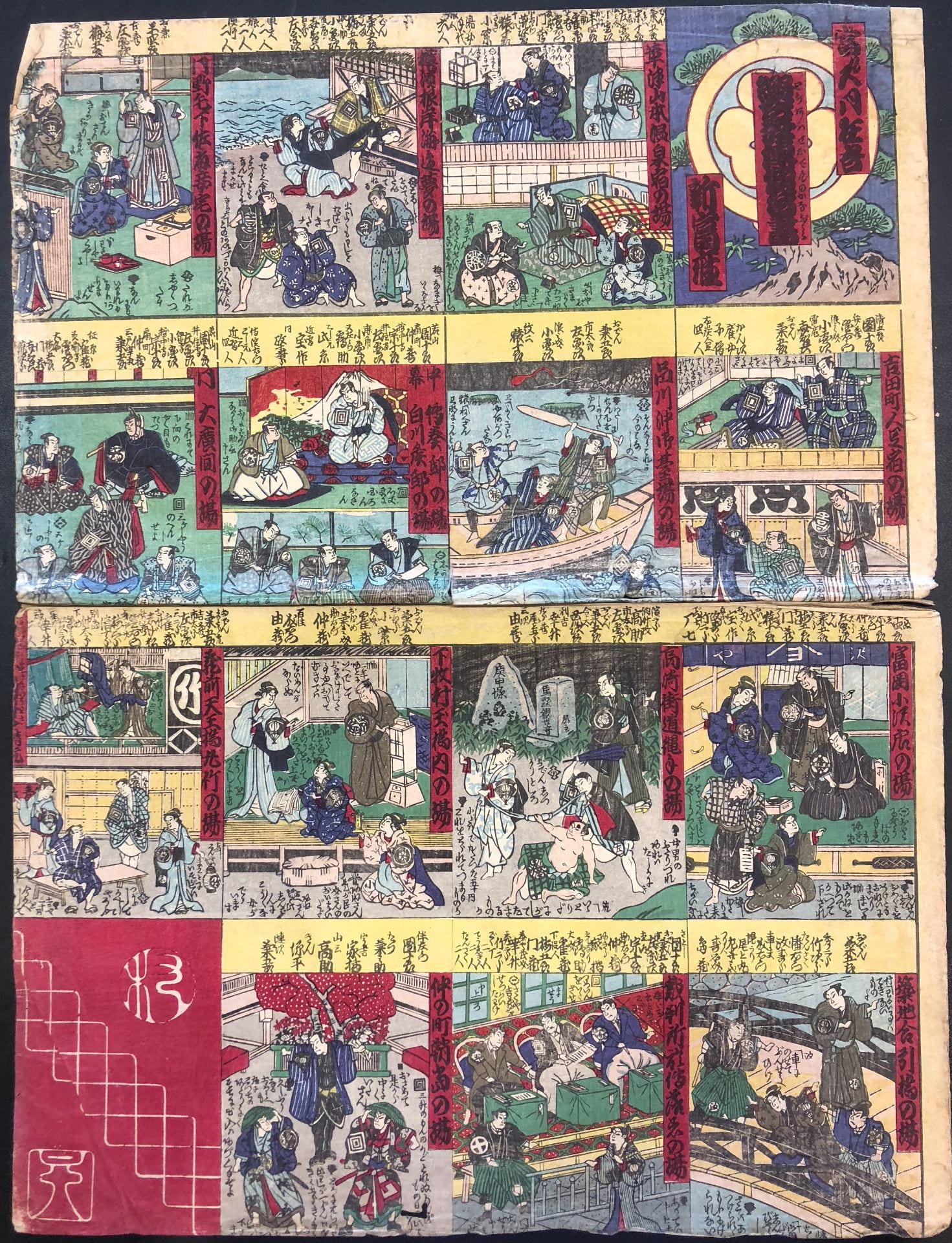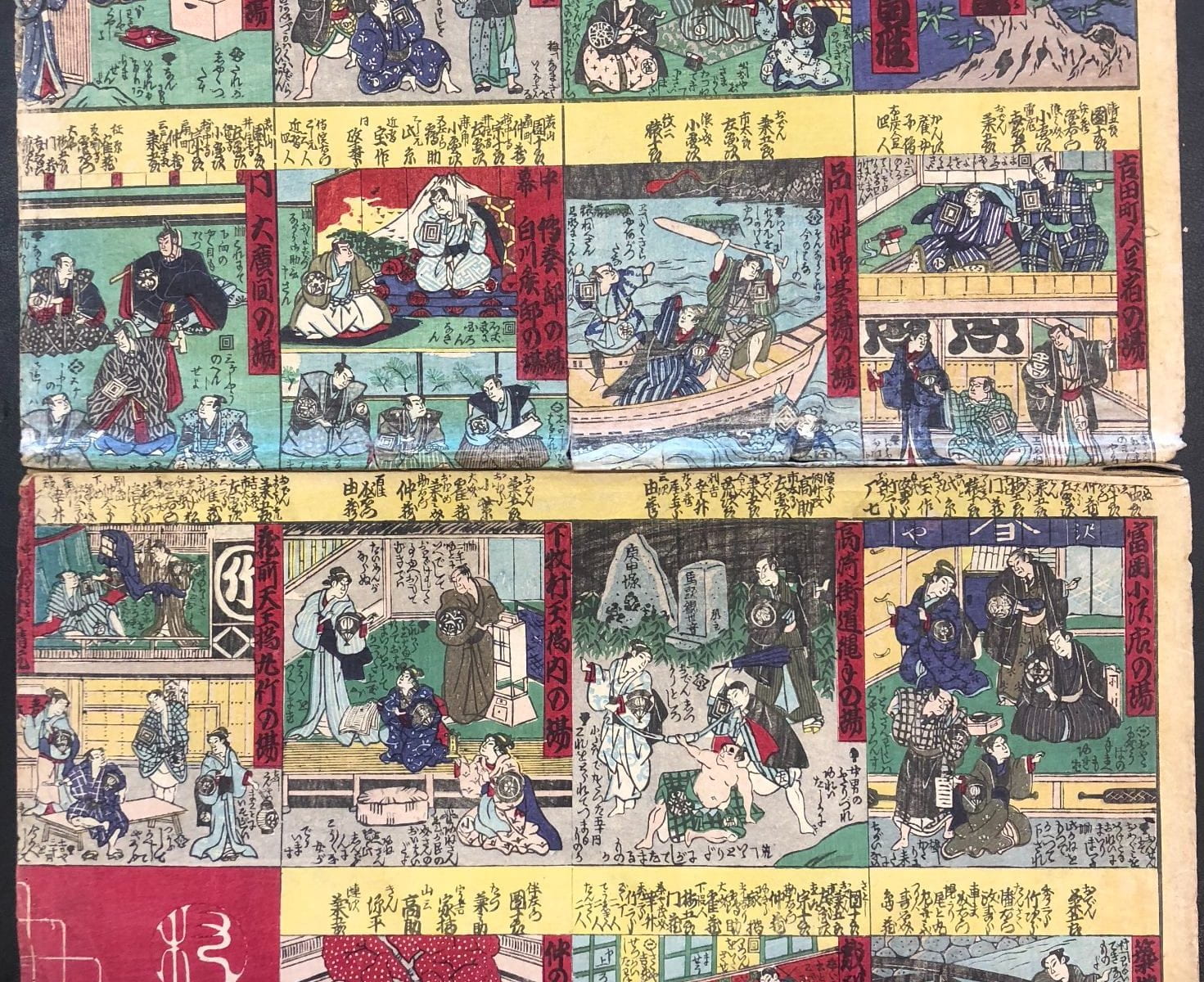
Artist: Unknown
Title: Toji-awase Oden no kanabumi (The Binding of Oden’s Letters)
Date: ca. 1879
Medium: Woodblock-printed broadside, ink and color on paper
This broadsheet refers to the kabuki play The Binding of Oden’s Letters (Toji-awase Oden no Kanabumi), written by Kawatake Mokuami. The play debuted at the Shintomi-za theater in 1879, and this broadsheet was likely made as a summary to the play. It includes 16 individual panels read from right to left, top to bottom. The first panel in the uppermost right corner identifies the play and its theater, and the 14 before the red square at the bottom left each represent a key scene in the narrative. The red cartouches on the right side of each panel describe the scene and location; above and outside the frame of each panel, within the yellow segment, is a list of roles and associated actors. Dialogue from the scenes is included within panel, and the actor’s costumes display their distinctive crests (mon). This broadsheet may have been made as a guide distributed at the theater or as memorabilia to take home from a performance.
The kabuki play was based on sensational stories about a woman named Takahashi Oden (ca.1848-1879). Oden gained media attention when she was arrested in 1876 under suspicion of cutting the throat of merchant Gotō Kichizō at an inn before fleeing the scene. Oden’s trial spanned nearly 3 years before she was convicted under the Meiji-era justice system. On January 31, 1879, she became one of the last persons in Japan to be officially executed by beheading. The kabuki play based on her story debuted in the Shintomi-za theatre in May of that year.
Comparatively little can be verified about the real Takahashi Oden. Her literary appearances, on the other hand, in gossip serials that appeared in newspapers within days of her death as well as the books and plays that followed, provide a wealth of shifting details about her life. Due to the immediate and sensationalist coverage of her crime, Oden was termed a “poison woman,” by mass media after her alleged poisoning of her sick husband was added to the list of criminal accusations including gross immorality, thievery, and murder. The term “poison woman” or dokufu gained traction in Meiji Japan through publications featuring female criminals (see Marran).
Reporter Kanagaki Robun (1829-1894) wrote The Tale of Demon Takahashi Oden (Takahashi Oden yasha monogatari) in 1879; this has become perhaps the best-studied version of Takahashi Oden. It first appeared in the newspaper Kanayomi as a serial called the The story of poison woman Oden (Dofuku oden no hanashi). The serial began two days after Oden was beheaded and its immediacy likely lent to its popularity. It was later expanded into book form. Robun’s work predates the Kabuki play version of Oden by 3 months.
The script for the kabuki play, Toji-awase Oden no kanabumi, that is the reference for this broadsheet remains extant, available digitally in the database maintained by the National Institute of Japanese Literature. The play was organized with six acts, and the panels in the broadsheet line correspond to that work as follows:
Panel 1: Play title and theater
Panel 2: Opening act
Panels 3 and 4: Second act
Panels 5 and 6: Third act
Panels 7 and 8: Interlude performance featuring material unrelated to Oden
Panel 9: Fourth act
Panel 10: Intermediate act
Panel 11: Fifth act
Panels 12, 13, 14, 15: Sixth act
The play has yet to be translated or analyzed in detail but a great deal of attention appears to be given to detailing Takahashi Oden’s life before and during her husband’s illness. In the broadsheet, some panels depict her being harassed by unsavory fellows alongside what appears to be her husband in worsening condition. In a panel midway, Oden is depicted as distressed aboard a boat, hounded by a ghost-like figure—this is likely her husband after his death. The panels following the intermission scenes may depict Oden cohabiting with another man as well as her involvement in his enterprises. The final panels illustrates the climax of the play. In the 12th panel, Oden is seen luring and killing a man on the second floor of an inn, in the 13th panel she is captured by officials on a bridge, in the 14th panel she is standing trial, and in the 15th panel she is sentenced. A study group at the University of Pennsylvania is currently working on a full transcription of the broadsheet.
Other collections: as yet no other copies have been found
Selected Readings:
Christine L. Marran, Poison Woman: Figuring Female Transgression in Modern Japanese Culture (University of Minnesota Press, 2007).
Ohashi Yoshiteru, Dokufu densetsu Takahashi Oden to Eriito Gunitachi (Kyoei Shoten, 2013).
Matthew C. Strecher, “Who’s Afraid of Takahashi O-Den? ‘Poison Woman’ Stories and Literary Journalism in Early Meiji Japan.” Japanese Language and Literature, vol. 38, no. 1, 2004, pp. 25–55.
Posted by Caitlin Adkins, April 6, 2022

